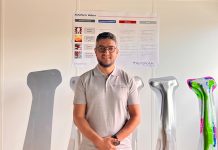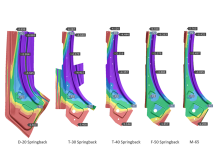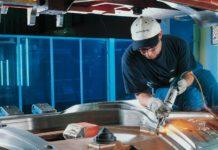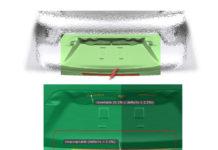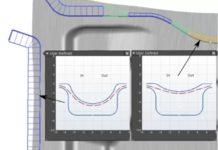Why Focusing on the Problem Area with Splits is NOT Always the Right Place to Find Your Solution – Another Look at the AK Steel/Ford Project presented at Great Designs in Steel (GDiS) 2015
[dropcap]C[/dropcap]an we always ‘think it out?’ During an analysis of a project with Ford and AK Steel it was demonstrated, through the use of AutoForm-Sigma, that focusing on the problem area might not always be the right place to apply a solution to get it right.
In 2015 a project was done jointly with AK Steel and Ford to remedy a problem panel. AK Steel was the material supplier for the F250 box side outer panel.
During tryout it was seen that panel splits occurred along the lower draw wall at the bottom of the stroke. The process of bead grinding was very time consuming and led to blank slipping past the beads on the lower side of the panel.

Left panel splits. Right Panel Slips F250 Ford
With product geometry, and therefore draw surfaces, finalized and not allowed to be modified, and without opportunity for significant process changes, adjusting the beads was the only option, presenting quite a challenging during tryout.
Dr. Yu-Wei Wang, Applications Engineering Manager from AK Steel said ‘The process was very sensitive, as a small amount of bead change meant not holding the material tight enough, leading to slippage of the material and lack of stretch. Then, tightening the beads, even just a little bit, caused splitting at one end. The problem was that it wasn’t very intuitive in terms of knowing which bead to fix, so when done in actual tryout this made correction extremely difficult and time consuming.’
Kidambi Kannan, Technical Manager at AutoForm U.S.A added ‘AutoForm wasn’t used during the tryout phase. We were interested and were provided with all the data thanks to the generosity of the original project team. We were then able to analyze the data using Sigma, not only confirming the susceptibility of forming outcomes to small changes in bead strength, but also establishing a viable and balanced solution.’

Worst case result in “simulation-cluster” – identifies all split locations
This is where things got interesting. One of the byproducts of going through this analysis was that Sigma demonstrated influences at play that were completely counterintuitive and surprising.
The Sigma analysis demonstrated a situation whereby control on one side of the panel was in fact more effectively done by controlling the draw beads on the OTHER side of the panel. ‘This is something you typically do not immediately think of’ says Kannan, adding ‘Tryout problems on a panel are typically addressed by adjusting material flow control – bead, tonnage, lube, shims – in the vicinity of observed issues. While the counterintuitive condition observed here can be explained and rationalized, that is after the fact. When you’re in tryout, in a physical setting looking at a part with your own eyes it’s likely that you’re going to work on the beads on the problematic side.’

Max. Failure result showing counterintuitive dependence
of lower draw wall splits on top side beads
AutoForm’s analysis of the tryout condition may be considered a post-mortem assessment; the project team had already corrected these issues through manual tryout. However AutoForm-Sigma was indeed very effective in identifying what the problem was, and establishing a solution in terms of adjusted bead shapes. The simulated outcome of this solution produced draw-in and formability results very similar to those measured on panel following manual adjustments in tryout. As an extension to this offline assessment, AutoForm then ran a robustness assessment to confirm that the established solution would continue to turn out the same quality of drawn panels despite noise variations – material, lube, coil width, blank location.
What can be learned therefore from the joint efforts of AK Steel, Ford and AutoForm?
A “green” nominal process, engineered based on one-off simulations, does not say anything about its sensitivity to process conditions, and its susceptibility to uncontrolled production noise. Early and extended work, in the digital world, towards development and validation of a truly stable process, is well worth it to minimize cost and time overruns during tryout and production.
Stay tuned for more and don’t forget to subscribe to our blog fur future posts.




